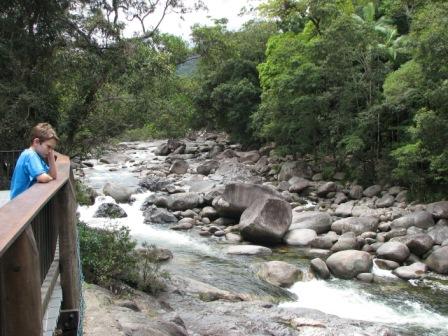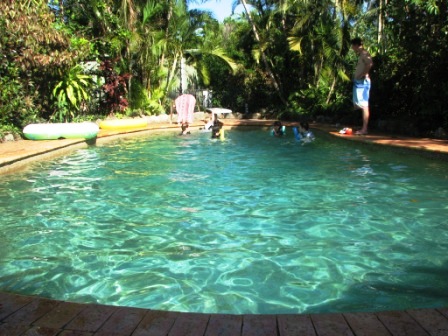Norfolk Island - How it Became Populated.

Norfolk Island is a tiny South Pacific Island, halfway between New Zealand and New Caledonia. Green, hilly and a long way from anywhere, it takes two and a half hours in a plane from Brisbane or Sydney (Australia) and one and a half hours from New Zealand.
Beautiful, unspoilt and organic, Norfolk Island is an extinct volcano. It is the only above ocean part of a rocky ridge that runs from New Zealand to New Caledonia. Where the rocky ridge rises majestically from the ocean, golden sand has congregated around some edges. Where there is no sand, the island edge is instead dimpled with rock pools of azure blue. Wherever you are on the island and wherever you look, Norfolk Island provides amazing views of either unspoilt coastlines and never ending blue, blue, blue ocean or green forested rolling hills, guarded by majestic and tall Norfolk Pines.
Norfolk Island is its own country. You need a passport and visa to go there and they have their own Island rules and regulations. Their government is made up of only nine politicians who work in a magnificent old building made by convicts.
Norfolk Island had three beginnings at becoming populated:

- The first settlement (1788-1814). Although discovered by Captain James Cook on his second voyage in 1774, there weren't any people around to live on the island until 1788. England had banished their convicts to a hard life in Australia and as soon as they all arrived, the English masters were keen to get their hands on the other beautiful little Island that Captain Cookie boy had described as "paradise". Cook had noted in his ships log that Norfolk Island was covered with tall pine trees (Norfolk pines) with plenty of flax that looked as thought they would make good masts for ships and sails. A small party of convicts and mean guards were sent immediately to claim the Island and to collect food to send back to the starving new colony at Botany Bay Australia.
Bad luck for the English: the Norfolk Pines were unsuitable for ships and there was little food to feed the starving convicts and officers in charge of them. After killing off all the birds for food, the English decided to not only abandon the island but to destroy all the strong stone buildings that the convicts had made. The English did not want to make it easy for anyone else to claim the island, especially the French. By 1814, the English had taken all of the convicts back to Australia and the island had only broken remains of buildings. The English bashed and raided the island and left her bleeding and alone, spoilt so that nobody else would want her. - The second settlement (1826-1856). Imagine if after the first sad start and end of Norfolk Island that things got better. Unfortunately, things got worse. In 1826, The English settlers of the penal colony in Australia needed somewhere to send the worst of the worst convicts. Already sent away from their families by being banished to Australia, the English governors punished the convicts a second time by sending them to Norfolk Island. This time there was nothing nice; no semi freedom for the convicts. The conditions were harsh beyond belief and the lives of the convicts meant nothing. There was no plan for the convicts to ever return to the mainland of Australia and nobody cared about them. They starved, drowned as they worked, or died from disease of filthy conditions. They slaved in chains to build magnificent stone buildings (the stone was quarried from under the ocean) but never got the opportunity to enjoy seeing what they had built. The conditions, suffering and cruelty they endured caused an outcry from people who cared about human life and the Norfolk penal settlement was again abandoned. The few surviving convicts were sent to Tasmania and the island again sat alone and uninhabited. During this second settlement, Norfolk Island was referred to as "Hell in the Pacific."
- The third settlement (June 8, 1856). The British Government declared Norfolk Island as an independent settlement and allowed the descendants of the Bounty mutineers to move to the island. Embarrassed by these people and their ties to a mutiny against the British Navy, England didn't know what to do with them. The mutineers had settled on Pitcairn island (they married Island women and had many babies), but the island was so small that it could no longer support them all. Norfolk was uninhabited, was viewed by the English as unworkable, and so the descendants of the Mutiny on the Bounty were granted the right to settle there.
In the loving hands of these people from Pitcairn Island, people who understood the precious balance of nature and island life, Norfolk Island has risen from it's gory and sad history to become a safe and jeweled island paradise. Nowadays, Norfolk Island has approximately 2000 people living on her. These people take very good care of her and protect her from misuse, disease and over population.

Norfolk Island has the second cleanest air in the world. The cleanest air is in Antarctica but its a little too cold to live there! Norfolk Island has no snakes or poisonous spiders and is a safe and healthy haven for children to explore. No fruit or vegetables are allowed to be imported onto the island so that the island's disease free status can be maintained.
The biggest pest on the island is the feral chickens (chooks). They roam where they want, digging up people's vegetable gardens and making havoc in flower gardens. Nobody seems to like the wild chooks and everybody would like them gone.
Because the island is so small (8km by 5km), the government has to be careful about how many people live there and how many tourists can visit. The island is an interactive museum. You don't just see and hear about history on Norfolk Island, you live it, walk on it, touch it. Too many visitors would destroy the natural beauty and living history of the island.
Norfolk Island has become our new family holiday place. We will go there every year because it is beautiful, safe and healthy. Living with the Australian history of the island also makes a visit to the island an educational experience that no other place can match.
If you'd like to visit Norfolk Island you can fly there with either Qantas or Air New Zealand. Start saving your pocket money. Not only is it a beautiful place to visit, it also boasts having the cheapest Lego in the world. Cool!







1 comment:
Hey Bride
Great to hear you had a wonderful time! Would love to catch up for coffee or something more celebratory!
Birdwing
xx
Post a Comment